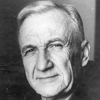From Graduate Studies to Bomb Design: 1945-1950
Sakharov returned to Moscow in early 1945 as a graduate student at “FIAN,” the Physical Institute of the USSR Academy of Sciences. He matured professionally and socially under the influence of Igor Tamm, the head of FIAN’s theoretical department. Tamm was a student of Leonid Mandelstam and maintained, even during the most difficult years of Stalin’s rule, the Mandelstam school’s tradition of combining high professionalism with high moral standards.
“On the morning of 7 August I left the house for the bakery and stopped by the newspaper displayed on the newspaper stand. I was struck by the report of Truman’s announcement: on 6 August 1945 at 8 a.m. an atomic bomb of the enormous destructive power of 20 thousand tons of TNT was dropped on Hiroshima. My knees buckled. I realized that my life and the life of very many people, maybe all of them, had suddenly changed. Something new and terrible had entered our lives, and it had come from the side of the Grand Science – the one that I worshipped.”
Sakharov was invited to join the Soviet atomic bomb project in 1946, and again in 1947, but he declined because he did not want to part from fundamental science and from Tamm, his beloved mentor. Meanwhile he received his Ph.D. in 1947 for work on particle physics. However, in June 1948, Tamm himself was commissioned to help Yakov Zeldovich and his research team to study the feasibility of a thermonuclear, or hydrogen, bomb. Tamm and several of his students, including Sakharov, formed a special auxiliary group at FIAN to work on a proposal for an H-bomb.
The USSR’s highest priority at that time was to produce an atomic bomb to counter the American nuclear power. The all-out research and industrial effort, directed by physicist Igor Kurchatov and assisted by atomic espionage, would be completed with the first Soviet nuclear test on 29 August 1949. As for the H-bomb, in theory vastly more powerful and therefore named the Super-Bomb, nobody knew whether it was possible at all. Only a few Soviet physicists were occupied with this problem. They began by considering a design nicknamed Truba (“tube” in Russian), with ideas initiated by information obtained by spies from the Manhattan Project in the United States.
Sakharov soon came to realize that the Truba design lacked promise. He suggested a radically new scheme which was named Sloyka, the Russian for a layered pastry. Vitaly Ginzburg, another student of Tamm, added another key idea about the right “filling” for this pastry – thermonuclear explosive material.

